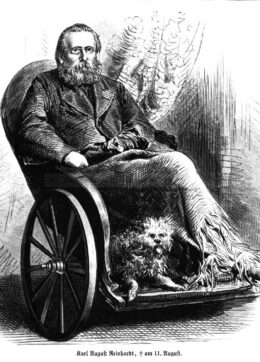
Printed
10 pages
Author(s)
Kasperl als Rekrut in der Türkei
In 1852 Carl Reinhardt published a series of pieces for Kasperl to go with the illustrated plates he was publishing in the Münchner Bilderbogen. The text, written by an unknown author, thus serves primarily as a caption for a graphic work that made Reinhardt the father of the comic strip in Germany, and was certainly not intended to be performed on stage. Nevertheless, these short sketches reproduce typical scenes and routines from the puppet repertoire of the time - in which they also relay racist stereotypes, in this case the depiction of Oriental despotism and Ottoman cruelty, the appearance of two mercantile and cowardly Jews, or that of Marshal Morackel, whose name suggests that he is a Moor, and whom Reinhardt in fact draws under the guise of a Black man.
The hero rebels against despotism
Sultan Mustapumpum still needs more soldiers to send his army to massacre the Christians, whom he wants to turn into tongue and ear salad for his meal. On the orders of Marshal Morackel, the recruiter of the Sultan's army tries to recruit the Jews Schmuel and Zwirn, who immediately flee; then he recruits Kasperl. But Kasperl knocks Morackel out with the rifle he gave him for the exercise. The marshal catches him in the act and wants to have him hanged. Kasperl does it so badly that Morackel puts the rope around his neck himself to show him how. Kasperl hangs him and then kills the Sultan by hitting him with the gallows.
Publications and translations
Carl Reinhardt, Das wahrhaftige Kasperltheater, Münchner Bilderbogen, 1852
Louis Lemercier de Neuville, Histoire anecdotique du théâtre de marionnettes. Paris: Calmann-Lévy, 1892, p. 43-49.
(French)
